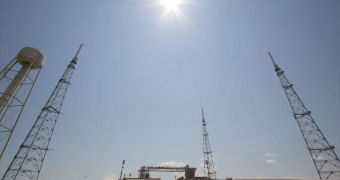Engineers at the NASA Kennedy Space Center (KSC), in Florida, reported on Wednesday, September 14, that the mobile gantries and the iconic towers that adorned the Launch Pad 39B facility have all been removed. The process started back in 2009.
At the time, US President Barack Obama had not yet ordered the independent review that would lead to the cancellation of Project Constellation, and to the creation of the new 2010 National Space Policy.
Under the guises of the former, Bush-era effort, LP-39B was to be converted into an installation capable of supporting the launch of ARES I delivery systems. These were the rockets originally intended to carry the Orion Crew Exploration Vehicle to the Moon.
A test flight of the system took place on October 28, 2009, from the now-clean launch pad. The mission saw that ARES I-X soaring to the sky, proving the engines and flight controls it was equipped with.
However, after Project Constellation was canceled, development of the ARES I, I-X and V was dropped, as was the Altair lunar lander and the Earth-Departure Stage (EDS) motors. Orion was converted into a trimmed-down version of itself, called Multi-Purpose Crew Vehicle (MPCV).
Workers soon began clearing Launch Pad 39B of the installed components. At this point, the solid platform has the ability to launch nearly any type of manned or unmanned mission. NASA and the KSC are pondering renting the space to private space companies.
Another possible use would be to use it for supporting the Space Launch System (SLS) heavy-lift rocket, which NASA announced just a few days ago. The vehicle is scheduled to fly for the first time no earlier than 2017, Space reports.
This would give engineers ample time to conduct the necessary preparatory work, so that the rocket becomes compatible with the pad. Even if this plan does not materialize, the launch pad will be used by other companies, which will have to bring their own mobile gantries.
Overall, the KSC is outsourcing and renting some of its installations, due to the fact that the Space Shuttle Program (SSP) has been terminated after 30 years of activity. Much of the infrastructure present at the spaceport is dedicated to supporting the orbiters.
Some of these installations now appeal to several private companies, which work either alone or with NASA for developing manned and unmanned capsules capable of delivering astronauts or cargo to the International Space Station, low-Earth orbit, near-Earth asteroids, Mars, and beyond.

 14 DAY TRIAL //
14 DAY TRIAL //